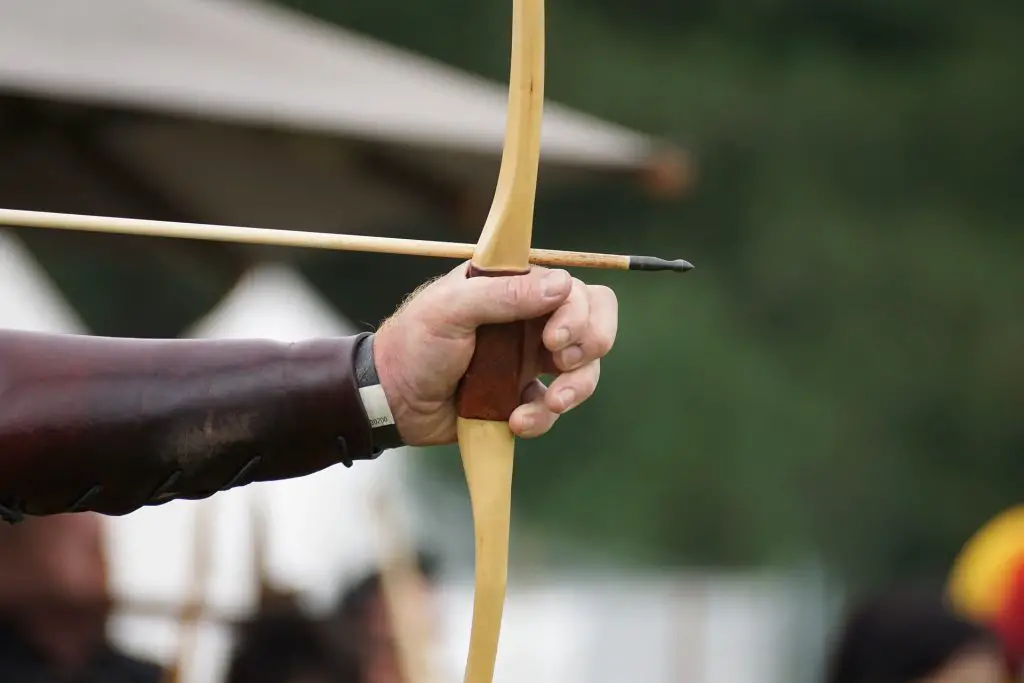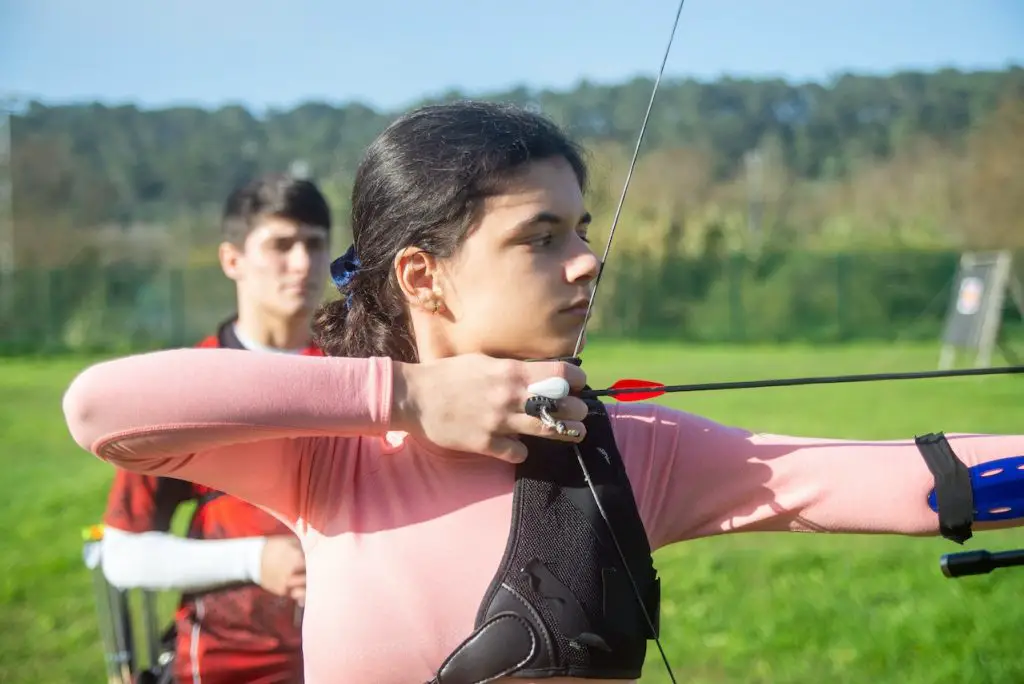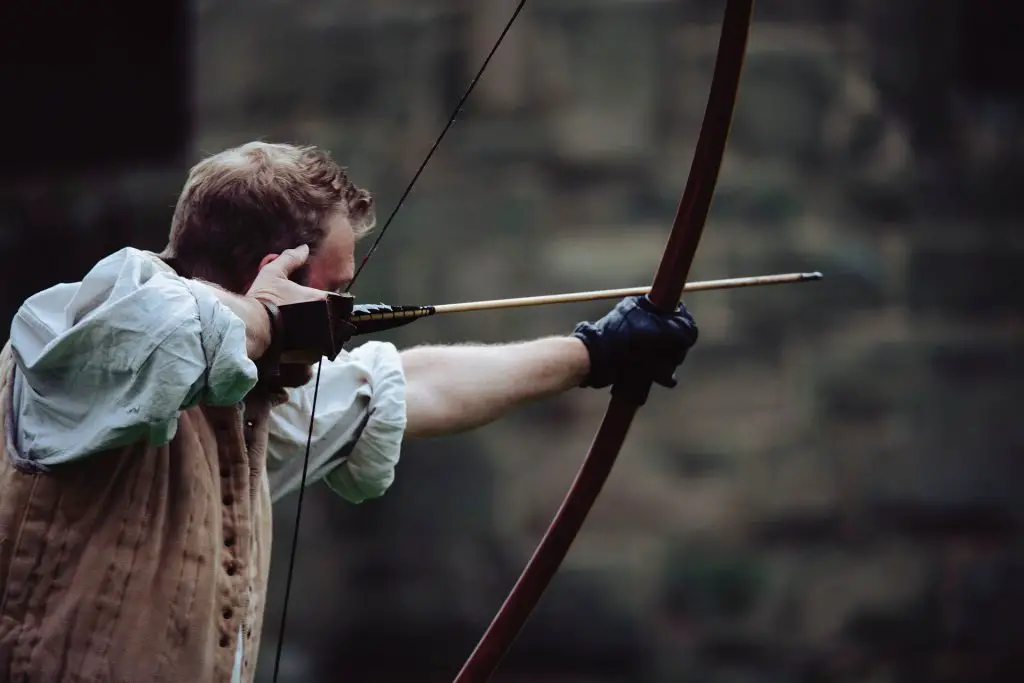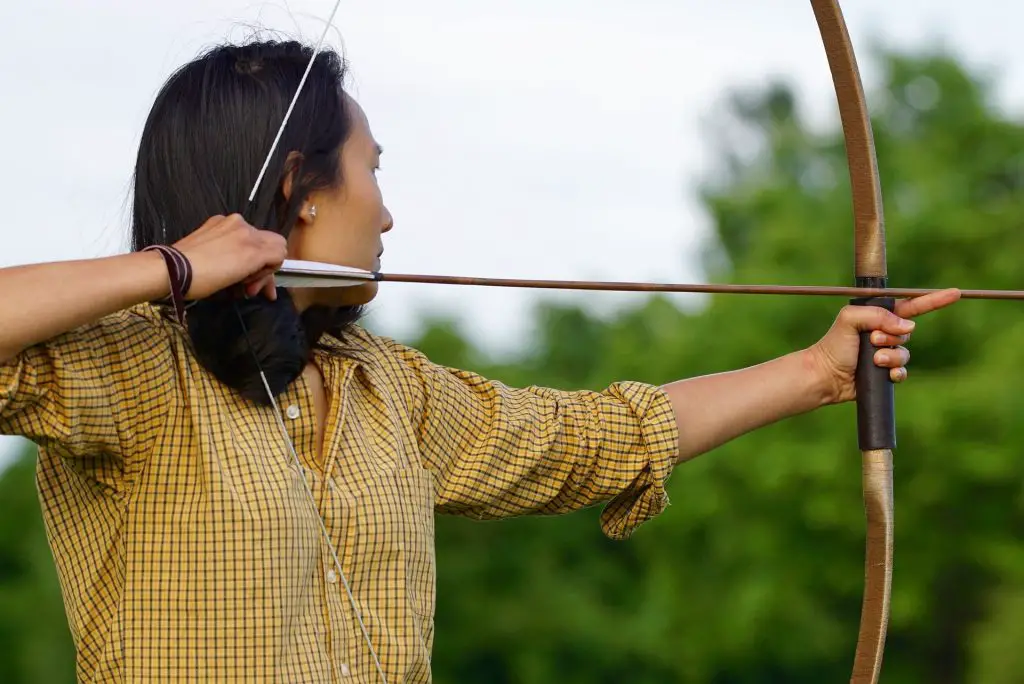How To Aim A Recurve Bow Without A Sight: All Methods

Archery is a sport that has been around for thousands of years and still continues to captivate enthusiasts.
It requires precision, accuracy, and focus to hit the target successfully. While most modern bows come with sights that aid in aiming, traditional recurve bows do not have this luxury.
Recurve bows are simple and elegant, and aiming without sight can be a challenging but rewarding experience.
In this article, we will discuss four methods to aim a recurve bow without a sight that will help improve your accuracy and consistency on the range or in the field.
We will cover the basic principles of aiming, along with tips and techniques to make the process easier. With these methods, you will learn how to develop a consistent and effective aiming technique that will help you hit the target every time.
Whether you are new to archery or an experienced archer looking to improve your skills, this article will provide you with valuable insights and techniques to help you aim your recurve bow without sight.
So, let’s get started!
Method 1: Gap Shooting
Gap shooting is a technique that can be used to aim a recurve bow without using a sight.
It involves using the gap between the arrow tip and the target to estimate where the arrow will hit.
Here are the steps to use the gap-shooting method:
- Determine the distance to the target: Before you can use gap shooting, you need to know the distance to the target. You can use a rangefinder or estimate the distance based on the size of the target and your experience.
- Choose an aiming point: Look at the target and choose an aiming point, such as the center of the bullseye or a specific spot on the target face.
- Draw the bow: Draw the bow back to your anchor point. The anchor point is the spot where you consistently bring your hand to when drawing the bowstring back. This can be the corner of your mouth, your cheekbone, or your chin.
- Look at the gap: While holding the bow at full draw, look at the gap between the arrow tip and the aiming point. This gap will be different for each distance, so you’ll need to practice to get a feel for it.
- Release the arrow: When you are ready to shoot, release the arrow while maintaining your focus on the gap between the arrow tip and the target.
- Observe the arrow flight: Observe the arrow flight and adjust your aim as necessary based on where the arrow hit in relation to the aiming point. If the arrow hit above the aiming point, aim a little lower on the next shot. If it hit below, aim a little higher.
- Practice: The gap shooting method takes practice to master, but with time and experience, you can become proficient in aiming your recurve bow without sight using this technique.
One of the benefits of gap shooting is that it can be used for any distance.
However, it takes some practice to determine the correct gap for each distance. It also requires a consistent anchor point to ensure consistent shooting.
It is essential to note that the gap method does not work for everyone.
Factors such as arrow weight, draw length, and bow type can affect the gap, making it challenging to determine the correct aiming point.

Method 2: String Walking
String walking is another popular method used to aim a recurve bow without a sight.
This technique involves changing the position of the anchor point along the string to adjust the distance between the bow and the target.
Here’s how to do it:
- Nocking the Arrow: As with gap shooting, start by nocking the arrow on the bowstring and gripping the bow handle.
- Anchor Point: Next, anchor the bowstring at a specific point on your face or chin. The anchor point should be consistent and comfortable for you to maintain.
- Draw the Bowstring: Draw the bowstring back until you reach the anchor point, and hold it steady.
- Find the String Walking Point: Identify the point where the arrow meets the riser of the bow, known as the bow’s nocking point.
- Position the Fingers: Position your fingers beneath the nocking point, so that the arrow is positioned further away from the bow, increasing the distance between the arrow and the target.
- Adjust for Distance: Move your anchor point up or down the bowstring to adjust the distance between the bow and the target. The higher up the string you move your anchor point, the further the arrow will travel, and the lower down the string you move your anchor point, the shorter the arrow’s travel distance will be.
String walking can be more precise than gap shooting and is commonly used in field archery where different distances are shot.
It’s important to note that string walking can also change the bow’s draw weight, so you may need to experiment to find the best combination of anchor point and draw weight for your shooting style.

Method 3: Instinctive Shooting
Method 3 for aiming a recurve bow without sight is called instinctive shooting.
As the name suggests, this method relies on the archer’s instincts and muscle memory to aim accurately. Instinctive shooting is a challenging method, but it can be very rewarding once mastered.
Here’s how to practice instinctive shooting:
- Start by standing a few feet away from your target.
- Close your non-dominant eye and focus on the target with your dominant eye.
- Raise the bow and draw the string back to your anchor point.
- Without looking at the bow or the arrow, aim at the target and release the arrow.
The key to instinctive shooting is to practice consistently and develop muscle memory.
Over time, your brain will learn how to judge the correct aim based on the distance and angle of the target. It’s important to note that this method is not precise, and your accuracy will depend on your skill and experience.
To improve your instinctive shooting, try shooting at different distances and angles.
Practice consistently and aim for consistency in your shots rather than perfection. As you become more comfortable with the method, you may find that you’re able to hit smaller and more distant targets.
Instinctive shooting is a popular method among traditional archers and hunters, as it allows for quick and accurate shooting in the field. However, it requires a lot of practice and dedication to master.

Method 4: Face Walking
Face Walking is another technique that can be used to aim a recurve bow without sight.
It involves using the position of the bowstring on the archer’s face to determine the aiming point.
The archer needs to establish a consistent anchor point on their face by positioning the bowstring at a specific point on their nose or mouth, which becomes the reference point for aiming.
To start with, the archer needs to identify their anchor point, which is where they consistently pull the bowstring back to their face. This can be a point on their nose or mouth, and once they have established it, they need to draw the bowstring back to this point every time they shoot.
The archer then needs to determine the point on their face where the bowstring sits when they aim at the target. This is usually below the dominant eye and is referred to as the “string picture.”
To aim using the face walking method, the archer needs to line up the string picture with the target. This can take some practice to get right, as it involves a combination of muscle memory and visual awareness.
The key to successful face walking is consistency.
The archer needs to ensure that they are pulling the bowstring back to the same anchor point every time and that they are positioning the string at the same point on their face for every shot. This can be challenging, but with practice, it can become second nature.
The archer needs to be patient and persistent and should expect to go through a lot of trial and error before they become proficient at it.
In conclusion, there are several methods that can be used to aim a recurve bow without sight.
Each method has its advantages and disadvantages, and it is up to the individual archer to find the method that works best for them.
With practice and dedication, any archer can learn to shoot accurately without a sight and enjoy the challenge and satisfaction of traditional archery.
Other Methods
Barebow Or Traditional Method
Another method for aiming a recurve bow without a sight is the “barebow” or “traditional” method.
This method involves using a consistent anchor point and hand placement and relying on muscle memory and practice to develop a sense of where the arrow will go.
With this method, the archer focuses on the target and draws the bow to a consistent anchor point, usually the corner of the mouth or the jawbone.
The archer then aims by aligning the bow and arrow with the target, using their own intuition and experience to gauge the correct aim.
This method requires a lot of practice and is not as precise as the other methods, but it can be satisfying for those who prefer a more instinctual and traditional approach to archery.
String picture or String tracking
One additional popular method of aiming a recurve bow without a sight is called the “string picture” or “string tracking” method.
In this method, the archer visualizes an imaginary picture or shape formed by the string in relation to the bow and the target. The archer uses the location of the string picture in relation to the target to aim and shoot the bow.
To use the string picture method, the archer needs to find the anchor point on their face and consistently maintain that position. Then, the archer draws the bowstring back and visualizes the shape formed by the string and the bow limbs. The archer aligns the shape with the target and releases the arrow.
The string picture method requires practice and experience to develop the ability to consistently visualize the shape and aim accurately. It is a popular method among traditional archers who prefer to shoot without a sight.
Conclusion
In conclusion, there are several ways to aim a recurve bow without a sight.
The popular four methods discussed in this article are gap shooting, string walking, instinctive shooting, and face walking.
Each method has its own advantages and disadvantages, and it’s up to the archer to choose which one works best for them.
Gap shooting involves using the gap between the arrow and the target as a reference point for aiming. String walking involves moving the finger position on the string to adjust for different distances.
Instinctive shooting relies on muscle memory and practice to shoot accurately without aiming. Face walking involves using the position of the arrow in relation to the shooter’s face as a reference point.
Other methods that may be worth exploring include the point-of-aim method, where the archer aims at a specific point on the target, and the split-vision method, where the archer splits their vision between the target and the bow.
Ultimately, the key to successful shooting is practice and finding the method that works best for you.
Regardless of the method chosen, it is important to always prioritize safety when handling a bow and arrow.
Make sure to follow proper safety protocols and take the necessary precautions when practicing your aim. With time, practice, and dedication, you can master the art of shooting a recurve bow without a sight.
You might be interested in

